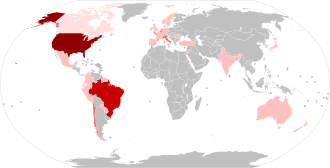
Back متحور غاما Arabic সার্স-কোভ-২ ভাইরাসের গামা প্রকারণ Bengali/Bangla Variant Gamma del SARS-CoV-2 Catalan SARS-CoV-2-variant Gamma Danish SARS-CoV-2-Variante Gamma German Variante gamma del SARS-CoV-2 Spanish سویه گامای سارس کووید ۲ Persian Variant Gamma du SARS-CoV-2 French Varian Gamma SARS-CoV-2 ID SARS-CoV-2 lignaggio B.1.1.28.1 Italian
| Gamma | |
 | |
| General details | |
|---|---|
| WHO Designation | Gamma |
| Other Names | 20J/501Y.V3, Variant of Concern 202101/02 (VOC-202101/02),[1] Brazilian variant or Brazil variant'[2][3][4] |
| Lineage | P.1 |
| First detected | Tokyo, Japan |
| Date reported | 6 January 2021 |
| Status | Variant of concern |
| Cases map | |
 Legend: 1,000+ confirmed sequences 500–999 confirmed sequences 100–499 confirmed sequences 2–99 confirmed sequences 1 confirmed sequence None or no data available | |
| Major variants | |
| Part of a series on the |
| COVID-19 pandemic |
|---|
 |
|
|
|
The Gamma variant (P.1)[a] was[6][7] one of the variants of SARS-CoV-2, the virus that causes COVID-19.[8] This variant of SARS-CoV-2 has been named lineage P.1 and has 17 amino acid substitutions, ten of which in its spike protein, including these three designated to be of particular concern: N501Y, E484K and K417T.[4][9] It was first detected by the National Institute of Infectious Diseases (NIID) of Japan, on 6 January 2021 in four people who had arrived in Tokyo having visited Amazonas, Brazil, four days earlier.[4][10] It was subsequently declared to be in circulation in Brazil.[4] Under the simplified naming scheme proposed by the World Health Organization, P.1 was labeled Gamma variant, and was considered a variant of concern until March 2022, when it was largely displaced by the delta and omicron variants.[11]
Gamma caused widespread infection in early 2021 in the city of Manaus, the capital of Amazonas, although the city had already experienced widespread infection in May 2020,[12] with a study[13] indicating high seroprevalence of antibodies for SARS-CoV-2.[14] A research article published in Science Journal indicate that P.1 infected people have a greater chance of transmissibility and death than B.1.1.28 infected ones.[15]
The Gamma variant comprises the two distinct subvariants 28-AM-1 and 28-AM-2, which both carry the K417T, E484K, N501Y mutations, and which both developed independently of each other within the same Brazilian Amazonas region.[16]
Gamma is notably different from the Zeta variant (lineage P.2) which also circulated strongly in Brazil. In particular, Zeta only carries the E484K mutation and has neither of the other two mutations of concern, N501Y and K417T.[16][9]
- ^ a b "Variants: distribution of cases data". gov.uk. Public Health England. 27 February 2021. Retrieved 27 February 2021.
 This article incorporates text published under the British Open Government Licence v3.0:
This article incorporates text published under the British Open Government Licence v3.0:
- ^ a b "Covid-19: Brazil virus already in UK 'not variant of concern', scientist says". bbc.com. 15 January 2021. Retrieved 15 January 2021.
- ^ a b "COVID-19: Virologist says Brazilian coronavirus variant detected in UK is not the one 'of concern'". news.sky.com. 15 January 2021. Retrieved 15 January 2021.
- ^ a b c d e Cite error: The named reference
:0was invoked but never defined (see the help page). - ^ "Lineage P.1". cov-lineages.org. Retrieved 21 April 2021.
- ^ "Tracking SARS-CoV-2 variants". who.int. Retrieved 17 August 2022.
- ^ "Variants of concern". CDGN. Retrieved 17 August 2022.
- ^ Newey, Sarah (12 January 2021). "Third concerning coronavirus variant should be a 'wake up call' to the world, experts warn". The Telegraph. Archived from the original on 12 January 2022. Retrieved 17 January 2021.
- ^ a b COG-UK Report on SARS-CoV-2 Spike mutations of interest in the UK (PDF). cogconsortium.uk (Report). Covid-19 Genomics UK Consortium. 15 January 2021. Archived from the original (PDF) on 16 April 2021. Retrieved 25 January 2021.
- ^ "Japan finds new coronavirus variant in travelers from Brazil". Japan Today. Japan. 11 January 2021. Retrieved 14 January 2021.
- ^ Cite error: The named reference
:1was invoked but never defined (see the help page). - ^ Matt Rivers (28 January 2021). "Is a new coronavirus variant to blame for this Brazilian city's collapse?". CNN.
- ^ Buss, Lewis F.; Prete, Carlos A.; Abrahim, Claudia M. M.; Mendrone, Alfredo; Salomon, Tassila; de Almeida-Neto, Cesar; et al. (8 December 2020). "Three-quarters attack rate of SARS-CoV-2 in the Brazilian Amazon during a largely unmitigated epidemic". Science. 371 (6526). American Association for the Advancement of Science: 288–292. doi:10.1126/science.abe9728. ISSN 0036-8075. PMC 7857406. PMID 33293339.
- ^ Sabino, Ester C.; Buss, Lewis F.; Carvalho, Maria P. S.; Prete, Carlos A.; Crispim, Myuki A. E.; Fraiji, Nelson A.; et al. (27 January 2021). "Resurgence of COVID-19 in Manaus, Brazil, despite high seroprevalence". The Lancet. 397 (10273): 452–455. doi:10.1016/S0140-6736(21)00183-5. ISSN 0140-6736. PMC 7906746. PMID 33515491.
- ^ Faria, Nuno R.; et al. (31 May 2021). "Genomics and epidemiology of the P.1 SARS-CoV-2 lineage in Manaus, Brazil". Science. 372 (6544): 815–821. Bibcode:2021Sci...372..815F. doi:10.1126/science.abh2644. hdl:10044/1/92015. PMC 8139423. PMID 33853970.
- ^ a b Oliver T.R. Toovey; Kirsty N. Harvey; Paul W. Bird; Julian Wei-Tze Wei-Tze Tang (3 February 2021). "Introduction of Brazilian SARS-CoV-2 484K.V2 related variants into the UK". Journal of Infection. 82 (5): e23–e24. doi:10.1016/j.jinf.2021.01.025. PMC 7857057. PMID 33548358.
Cite error: There are <ref group=lower-alpha> tags or {{efn}} templates on this page, but the references will not show without a {{reflist|group=lower-alpha}} template or {{notelist}} template (see the help page).
© MMXXIII Rich X Search. We shall prevail. All rights reserved. Rich X Search